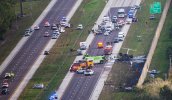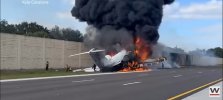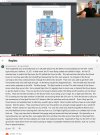CaptainDoug
Pre-Flight
- Joined
- Aug 18, 2022
- Messages
- 51
- Display Name
Display name:
Doug
Maybe from the vehicle that was hit...
Maybe from both the vehicle and the unusable fuel in the Challenger -
that could be up to about 40 gallons combined.
Sorry guys but I'm back to speculation mode.
A Dodge Journey carries about a similar amount of fuel
that a Challenger 600 has in unusable fuel ~ 20 gallons.
We can assume that there was the full amount of unusable
fuel still in the Challenger ~18 - 19 gallons - check page 12
of 13 on the PDF:
Assuming this Dodge Journey was full of fuel (probably not) we
can see that it still burns a lot. Don't forget how many things
catch fire after the gasoline / jet fuel ignites - seats
and everything else.

Car erupts in flames after driver hits deer on Minnesota highway
Neither the driver nor her dog were injured, but the deer did not survive, according to the local sheriff’s office.
 fox59.com
fox59.com
Now Hop-a-Jet was based in Fort Lauderdale as shown here:
<<According to the FlightAware aircraft tracker, the plane was operated by Hop-a-Jet Worldwide Charter based in Fort Lauderdale,
Florida. The aircraft had been scheduled to fly back to Fort Lauderdale on Friday afternoon>>
'We've lost both engines,' pilot said before private jet crashed onto Florida interstate, killing 2
A pilot and co-pilot were identified as the two killed in a fiery plane crash on a Florida highway, law enforcement officials said Saturday afternoon. The Collier County Sheriff’s Office identified Edward Daniel Murphy, a 50-year-old pilot and co-pilot Ian Frederick Hofmann, 65, as the...
Now I'm going out on a speculative limb by guessing that Hop-a-Jet could have been
cutting fuel quantities close to maximize profit. For example, just carry what you
need to get to APF and add the minimum to get to FXE or FLL - whichever one it is.
And there, Hop-a-Jet loads up on their cheap fuel for the next flight.
I will reiterate, this is all speculative. But in the razor-thin margin jet charter business,
this could have happened. There could have been a screw up on what fuel needed to
be on board to get to APF from Ohio. Even though it might have been getting really
low, the pilots could have said we'll make it anyway.
Don't shoot the speculator - but I'm just still not ruling out fuel exhaustion.







